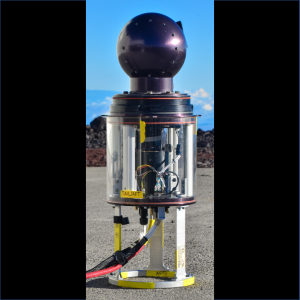4STAR (Spectrometers for Sky-Scanning Sun-Tracking Atmospheric Research; Dunagan et al., 2013) is an airborne sun-sky spectrophotometer measuring direct solar beam transmittance (i.e., 4STAR determines direct solar beam transmission by detecting direct solar irradiance) and narrow field-of-view sky radiance to retrieve and remotely sense column-integrated and, in some cases, vertically resolved information on aerosols, clouds, and trace gases. The 4STAR team is a world leader in airborne sun-sky photometry, building on 4STAR’s predecessor instrument, AATS-14 (the NASA Ames Airborne Tracking Sun photometers; Matsumoto et al., 1987; Russell et al. 1999, and cited in more than 100 publication) and greatly expanding aerosol observations from the ground-based AERONET network of sun-sky photometers (Holben et al., 1998) and the Pandora network of ground-based direct-sun and sky spectrometer (e.g, Herman et al., 2009).
4STAR is used to quantify the attenuated solar light (from 350 to 1650 nm) and retrieve properties of various atmospheric constituents: spectral Aerosol Optical Depth (AOD) from ultraviolet to the shortwave infrared (e.g., LeBlanc et al., 2020, Shinozuka et al., 2013); aerosol intensive properties - Single Scattering Albedo (SSA; e.g., Pistone et al., 2019), asymmetry parameter, scattering phase function, absorption angstrom exponent, size distribution, and index of refraction; various column trace gas components (NO2, Ozone, Water Vapor; e.g., Segal-Rosenheimer et al., 2014, with potential for SO2 and CH2O); and cloud optical depth, effective radius and thermodynamic phase (e.g., LeBlanc et al., 2015).
Some examples of the science questions that 4STAR have pursued in the past and will continue to address:
- What is the Direct Aerosol Radiative Effect on climate and its uncertainty? (1)
- How much light is absorbed by aerosol emitted through biomass burning? (1)
- How does heating of the atmosphere by absorbing aerosol impact large scale climate and weather patterns? (1)
- How does aerosol spatial consistency of extensive and intensive properties compare? (2)
- How does the presence of aerosol impact Earth’s radiative transfer, with co-located high concentration of trace gas? (3, 5)
- What is the impact of air quality from long-range transport of both aerosol particulates and column NO2 and Ozone, and their evolution? (3, 6)
- What are the governing properties and spatial patterns of local and transported aerosol? (1)
- How are cloud properties impacted near the sea-ice edge? (4)
- In heterogeneous environments where clouds and aerosols are present, how much solar radiation is impacted by 3D radiative transfer? And how does that impact the aerosol properties? (5)
(1) ORACLES: Zuidema et al., doi:10.1175/BAMS-D-15-00082.1., 2016; LeBlanc et al., doi:10.5194/acp-20-1565-2020, 2020; Pistone et al., https://doi.org/10.5194/acp-2019-142, 2019;Cochrane et al., https://doi.org/10.5194/amt-12-6505-2019, 2019; Shinozuka et al., https://doi.org/10.5194/acp-20-11275-2020, 2020; Shinozuka et al., https://doi.org/10.5194/acp-20-11491-2020, 2020
(2) KORUS-AQ: LeBlanc et al., doi:https://doi.org/10.5194/acp-22-11275-2022, 2022
(3) KORUS-AQ: Herman et al., doi:10.5194/amt-11-4583-2018, 2018
(4) ARISE: Smith et al., https://doi.org/10.1175/BAMS-D-14-00277.1, 2017; Segal-Rosenheimer et al., doi:10.1029/2018JD028349, 2018
(5) SEAC4RS: Song et al., doi: 10.5194/acp-16-13791-2016, 2016; Toon et al., https://doi.org/10.1002/2015JD024297, 2016
(6) TCAP: Shinozuka et al., doi:10.1002/2013JD020596, 2013; Segal-Rosenheimer et al., doi:10.1002/2013JD020884, 2014
Measurement Details
Integration Details
NASA P-3 Orion - WFF: Zenith #1 (FS796.5),
NASA C-130H - WFF: Modified Hatch Zenith port (FS 230 LH),
NRC Convair 580: Zenith port,
NASA DC-8 -AFRC: Zenith 62 ° no. 4 (FS1130 LH),
DOE G-1: Zenith port in modified top escape hatch
Additional Information
[Remote - Passive] sunphotometer and spectrometer;
Measurement Sampling Rate:
Adjustable, 0.1 to 4 Hz: 1Hz reported AOD, 1Hz reported Column Gas measurements, 0.1Hz reported Cloud properties, Aerosol intensive properties Variable (Operator controlled, minimum of 1 scan per 3 minutes);
Measurement Wavelengths:
Effective measurement range is 355 - 1650 nm;
Vertical Resolution:
The instrument measures the column integrated effect along the viewing vector, so the vertical resolution is determined by the accuracy of the aircraft position metadata;
Weight:
Head mounted in zenith port: 23 kg, Rack mounted spectrometers and support equipment:134 kg;
Size:
Head: 46 cm height x 25.4 cm diameter
Rack mount: 93 cm height x 48.3 cm width;
Power:
530 W (peak current 7A, average 5.2A);
Measurements Wavelengths:
We measure 1044 channels from 173.2 nm to 998.4 nm with the vis, and 512 channels from 949.8 nm to 1703.0 nm. Sampling at ~0.8nm for vis (0.75nm-0.81nm) and sampling at ~1.5 nm for nir (1.17-1.87 nm), with FWHM of slit resolutions of 1.8-7.2nm (mean of 3.2 nm) in vis (350 nm - 980 nm) and 4.5-8.6 nm (mean of 5.1 nm) in nir (990 nm to 1650 nm).
We report only our measurements from 354.1 nm to 1650.1 nm for AOD. Which is 801 channels in vis and 447 channels in nir. We may report our measurements in some circumstances down to 340 nm, and up to 1680 nm.


